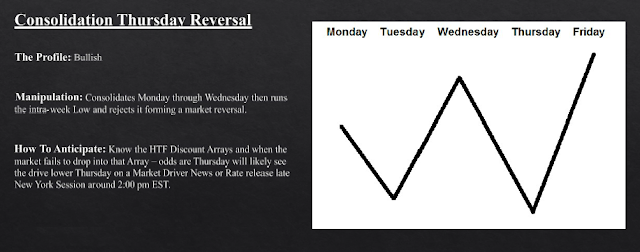The 3 Day Cycle is a recurring market cycle, that when identified, can be the groundwork of a trade setup. It consists of 3 days, and begins with a false break at the current weeks high or low. In his Best Trade Setups Playbook Stacey Burke described the 3 Day Cycle setups as either pump and dumps, or dump and pumps: "They [the market makers] pump, pump, pump, go sideways and drop a bit, one more small pump, then a dump. The dump can go straight down, fast. The pump up, may often be hard to trade on the first day, the price action can be choppy, and back and forth, a slow grinding auction. Other times, you are forced to "chase the move."
Finding Day 1:
Look for a false break above or below a previous day's high or low AT THE HIGH OR LOW OF THE WEEK.
Attributes of Day 1:
1. Breaks Below/Above Previous Days High or Low at the high of the week, and the day closes back inside of previous days range.
a. Sub Variation: Breaks through previous days level and days closes above/below that level.
Look for a false break above or below a previous day's high or low AT THE HIGH OR LOW OF THE WEEK.
Attributes of Day 1:
1. Breaks Below/Above Previous Days High or Low at the high of the week, and the day closes back inside of previous days range.
a. Sub Variation: Breaks through previous days level and days closes above/below that level.
The following day, price comes back inside of the the range from 2 days ago and closes.
2. Can become a First Green Day or First Red Day (Signal for following day).
3. Day 3 sometimes turns into Day 1 at the close of the day.
2. Can become a First Green Day or First Red Day (Signal for following day).
3. Day 3 sometimes turns into Day 1 at the close of the day.
Attributes of Day 2 of the 3 Day Cycle:
Day 2 can be either
1. Continuation in direction of false break; or:
2. It can turn into ...
a.) a First Red Day (FGD)
b.) a First Green Day (FRD)
c.) an Inside Day
d.) a Trend Day
Areas of Interest:
1. High of the Day/Low of the Day (HOD/LOD)
2. High of the Session/Low of the Session (HOS/LOS)
3. Outside Day/Inside Day (Was there a false break?) (Act as Support/Resistance)
4. Low Bear/High Bull (Support/Resistance)
Day 2 Trade Setups:
Day 2 can be either
1. Continuation in direction of false break; or:
2. It can turn into ...
a.) a First Red Day (FGD)
b.) a First Green Day (FRD)
c.) an Inside Day
d.) a Trend Day
Areas of Interest:
1. High of the Day/Low of the Day (HOD/LOD)
2. High of the Session/Low of the Session (HOS/LOS)
3. Outside Day/Inside Day (Was there a false break?) (Act as Support/Resistance)
4. Low Bear/High Bull (Support/Resistance)
Day 2 Trade Setups:
- Long/Short Squeeze
- Parabolic Trend Trade
- High of the Session/Low of the Session (HOD/LOD) Trade
- High of the Day/Low of the Day (HOD/LOD)
- Low Hanging Fruit (LHF) Continuation (Trend Trade)
- Parabolic Trend Trade
- High of the Session/Low of the Session (HOD/LOD) Trade
- High of the Day/Low of the Day (HOD/LOD)
- Low Hanging Fruit (LHF) Continuation (Trend Trade)
Method:
1. Support/Resistance References:
a. Low Bear/High Bull
b. Previous Days High/Low
c. HOD/LOD
2. Measure 3 Levels of rise/fall from Low/High of day for potential strike zone.
3. Use Support/Resistance References as additional confluence.
Attributes of Day 3 of the 3 Day Cycle:
1. Day 3 is the last day of the 3 Day Cycle.
2. A lot of times Day 3 can turn into Day 1, either on the current day or the next day
1. Day 3 is the last day of the 3 Day Cycle.
2. A lot of times Day 3 can turn into Day 1, either on the current day or the next day
(Reset of the Day Count).
3. Day 3 can either become a blow off trend continuation day (in the direction of the trend) or a reversal day.
Trade Setups:
1. Parabolic/Capitulation Trend
2. Reversal HOW/LOW
3. LHF Continuation (Trend Trade)
Areas of Interest:
1. Low/High of week
2. Previous Days High/Low (Support/Resistance/Trapped Volume)
3. High/Low of Day
4. High Bull/Low Bear (Support/Resistance)
5. OD/ID (Outside Day/Inside Day)
3. Day 3 can either become a blow off trend continuation day (in the direction of the trend) or a reversal day.
Trade Setups:
1. Parabolic/Capitulation Trend
2. Reversal HOW/LOW
3. LHF Continuation (Trend Trade)
Areas of Interest:
1. Low/High of week
2. Previous Days High/Low (Support/Resistance/Trapped Volume)
3. High/Low of Day
4. High Bull/Low Bear (Support/Resistance)
5. OD/ID (Outside Day/Inside Day)
Reference:
















%20-%20Trade%20Management%20%5B11%20p.%5D-04.png)
%20-%20Trade%20Management%20%5B11%20p.%5D-05.png)






























